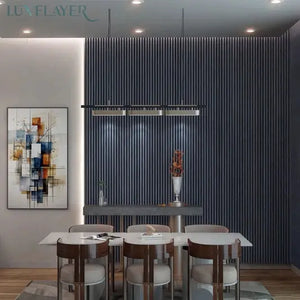Acoustics often take a backseat in home design and renovation, yet they play a crucial role in creating a pleasant and functional living environment. From echoing living rooms to noisy neighbors, acoustic issues can disrupt daily life. Fortunately, there are numerous strategies to address these problems, ensuring your home is a peaceful sanctuary.
Here, we'll explore practical solutions to fix the most common acoustic problems in your home, drawing on expert advice and innovative products available at LuxeLayer.
Understanding Acoustic Problems
Acoustic problems in homes stem from the interaction of sound waves with surfaces. Sound can be absorbed, reflected, transmitted, or diffused. Effective acoustic treatment involves balancing these interactions to create a pleasant auditory environment. Common issues include:Echo and Reverberation: Hard surfaces reflect sound waves, creating echoes.
Noise Transmission: Sound passing through walls, floors, and ceilings.
External Noise: Sounds from outside enter the home.
Room Acoustics: Poor sound quality within rooms, affecting comfort and functionality.
Step-by-Step Solutions to Common Acoustic Problems
Echo and Reverberation
Solution: Use sound-absorbing materials to reduce reflections.Implementation:
Furniture Placement: Position furniture to break up sound waves. Coffee tables, bookshelves, and plants can help diffuse sound.Soft Materials: Incorporate rugs, carpets, and curtains. Thick materials absorb sound better, reducing echo.
Install Acoustic Panels: Such as those provided by LuxeLayer, to effectively absorb sound.
Example:
In an open-plan living area, place a large rug in the seating area and use heavy curtains on windows. Add LuxeLayer’s acoustic wall panels to key areas to absorb sound and prevent echo.Noise Transmission
Solution: Enhance barriers to sound transmission through structural modifications and additional materials.Implementation:
Windows and Doors: Use double-glazed windows and solid-core doors. Adding weather stripping or sealant can also help to minimize gaps.Walls and Ceilings: Install soundproofing materials like RSIC-1 clips and Sound break boards. You can add acoustic panels or baffles for additional sound absorption.
Floors: Use thick carpets or rugs. For added insulation, LuxeLayer's soundproof mats can be placed under existing flooring.
Example:
For a bedroom facing a noisy street, install double-glazed windows and hang thick curtains. To further reduce noise, place a LuxeLayer soundproof mat under the carpet.External Noise
Solution: Strategic placement of barriers and absorptive materials can block or absorb external noise.Implementation:
Landscaping: Plant trees or hedges to act as natural sound barriers.Outdoor Acoustic Panels: Use products like LuxeLayer’s fiberglass quilted curtains to create absorptive barriers around the exterior of the home.
Example:
For a home near a busy road, plant a row of evergreen trees along the fence line. On exterior walls facing the noise source, install LuxeLayer's outdoor acoustic panels.Room Acoustics
Solution: Balance absorption, reflection, and diffusion to create a pleasant sound environment.Implementation:
Bookshelves and Cabinets: Place against walls to break up sound waves.Sound Absorbing Elements: Use items like LuxeLayer’s acoustic panels or baffles on walls and ceilings.
Room Layout: Position furniture and sound-absorbing materials strategically to balance sound.
Example:
In a home office, place a bookshelf filled with books against one wall. Install LuxeLayer’s acoustic panels on the adjacent wall to absorb sound and reduce noise from other parts of the house.Practical Tips for Common Areas
Living Room
Challenges: Large spaces, hard surfaces, and multiple noise sources.Solutions:
Large Rugs: Cover hardwood floors with large, thick rugs. Curtains: Use heavy, floor-to-ceiling curtains on windows. Acoustic Panels: Install LuxeLayer’s panels behind the TV and on walls to absorb sound.Bedroom
Challenges: External noise, sound from adjacent rooms, and structural noise.Solutions:
Soundproof Windows: Install double-glazed windows with thick curtains. Wall Panels: Use LuxeLayer’s acoustic panels on shared walls. Soundproof Mats: Place under carpets for additional noise reduction.Home Office
Challenges: Noise from other rooms, street noise, and poor sound quality during calls.
Solutions:
Room Separation: Use a separate room for the home office if possible.Absorptive Materials: Place a thick rug under the desk and use LuxeLayer’s acoustic panels on walls.
Furniture Placement: Position the desk against a wall with sound-absorbing materials like bookshelves or curtains.
Innovative Products from LuxeLayer
LuxeLayer offers a range of products designed to address various acoustic challenges:Acoustic Wall Panels: Available in a variety of finishes and custom sizes, these panels effectively absorb sound and reduce echo.
Soundproof Mats: Ideal for under carpets, these mats reduce impact noise and improve overall room acoustics.
Fiberglass Quilted Curtains: Perfect for exterior noise reduction, these curtains are customizable and easy to install.
FAQs
How do acoustic panels work?
Designed to absorb sound waves, acoustic panels reduce reflections and echo within a room. They work by trapping sound waves in their porous material, converting sound energy into heat.
Can I install soundproofing materials myself?
Indeed, numerous soundproofing materials feature easy installation designs. LuxeLayer's acoustic panels and soundproof mats, for example, come with installation instructions and are simple to set up with basic tools.
What is the best way to reduce noise from neighbors?
To reduce noise from neighbors, use double-glazed windows, solid-core doors, and acoustic panels on shared walls. Adding rugs, curtains, and furniture can also help absorb sound.
How can landscaping help with external noise?
Landscaping with trees, hedges, and other vegetation can act as natural sound barriers. These elements can absorb and deflect sound waves, reducing the amount of noise that reaches your home.
Are acoustic treatments expensive?
Acoustic treatments can vary in cost depending on the materials and products used. LuxeLayer offers a range of affordable solutions, from soundproof mats to high-end acoustic panels, catering to different budgets.
What are the benefits of improving home acoustics?
Improving home acoustics enhances comfort, reduces stress, and creates a more enjoyable living environment. It can also improve the quality of audio in home theaters and reduce noise-related sleep disturbances.
Conclusion
Fixing common acoustic problems in your home doesn’t have to be complicated or expensive. By understanding the nature of sound and using the right materials and strategies, you can create a comfortable and peaceful living environment. LuxeLayer’s range of acoustic products provides effective solutions for various issues, ensuring your home is a haven of tranquility.
For more information on acoustic solutions and to explore LuxeLayer’s products, visit LuxeLayer. Transform your home into a serene space with expert acoustic treatments that are both functional and aesthetically pleasing.



